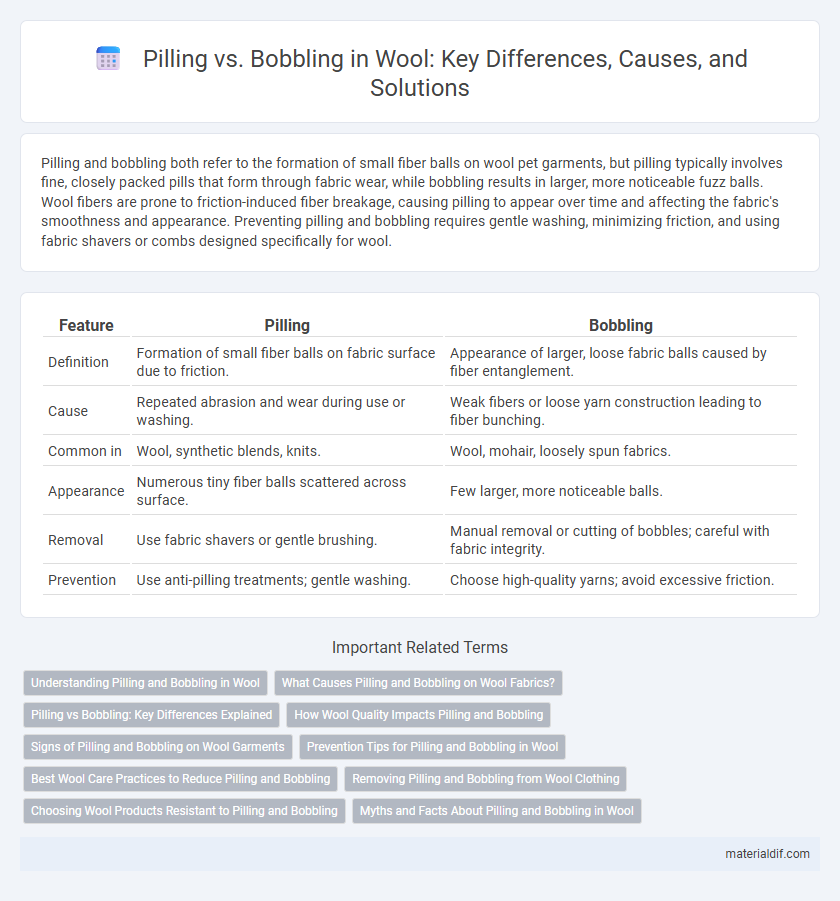Pilling and bobbling both refer to the formation of small fiber balls on wool pet garments, but pilling typically involves fine, closely packed pills that form through fabric wear, while bobbling results in larger, more noticeable fuzz balls. Wool fibers are prone to friction-induced fiber breakage, causing pilling to appear over time and affecting the fabric's smoothness and appearance. Preventing pilling and bobbling requires gentle washing, minimizing friction, and using fabric shavers or combs designed specifically for wool.
Table of Comparison
| Feature | Pilling | Bobbling |
|---|---|---|
| Definition | Formation of small fiber balls on fabric surface due to friction. | Appearance of larger, loose fabric balls caused by fiber entanglement. |
| Cause | Repeated abrasion and wear during use or washing. | Weak fibers or loose yarn construction leading to fiber bunching. |
| Common in | Wool, synthetic blends, knits. | Wool, mohair, loosely spun fabrics. |
| Appearance | Numerous tiny fiber balls scattered across surface. | Few larger, more noticeable balls. |
| Removal | Use fabric shavers or gentle brushing. | Manual removal or cutting of bobbles; careful with fabric integrity. |
| Prevention | Use anti-pilling treatments; gentle washing. | Choose high-quality yarns; avoid excessive friction. |
Understanding Pilling and Bobbling in Wool
Pilling and bobbling in wool both refer to the formation of small fiber balls on the fabric's surface caused by friction during wear. Pilling occurs when loose fibers tangle and form tiny, dense clusters, while bobbling describes larger, more pronounced fiber balls resulting from extended abrasion. Recognizing the differences between pilling and bobbling helps in selecting proper wool care techniques to maintain fabric quality and appearance.
What Causes Pilling and Bobbling on Wool Fabrics?
Pilling and bobbling on wool fabrics are caused by the friction and abrasion of fibers rubbing against each other or external surfaces. Loose or shorter fibers on the wool surface become entangled, forming small balls or pills that cling to the fabric. Differences in wool quality, fiber length, and fabric construction significantly influence the extent of pilling and bobbling.
Pilling vs Bobbling: Key Differences Explained
Pilling refers to the formation of small, tangled balls of fiber on the surface of wool fabric caused by friction during wear, while bobbling specifically describes larger, more noticeable clumps that result from repeated abrasion or washing. Pilling usually occurs uniformly across the fabric, whereas bobbling often appears as distinct patches or clusters. Understanding these key differences helps in selecting the right wool treatment and maintenance methods to prolong garment life and appearance.
How Wool Quality Impacts Pilling and Bobbling
Wool quality significantly impacts the formation of pilling and bobbling, as fibers with higher tensile strength and longer staple length resist fiber breakage that causes pills. Fine, high-grade wool such as Merino exhibits less surface abrasion, reducing bobble development compared to coarser wool types. Properly processed wool with smooth fiber cuticles maintains fabric integrity, minimizing pilling and extending garment durability.
Signs of Pilling and Bobbling on Wool Garments
Pilling on wool garments appears as small, fuzzy balls caused by fibers matting together due to friction, often found on high-contact areas like sleeves and underarms. Bobbling, a specific form of pilling, presents as dense, raised clusters of fibers that create uneven texture patches, commonly seen on sweaters and scarves. Both signs indicate fabric wear but differ in severity and texture, impacting the garment's appearance and comfort.
Prevention Tips for Pilling and Bobbling in Wool
To prevent pilling and bobbling in wool, regularly use a fabric shaver or depiller to gently remove fuzz balls without damaging fibers. Avoid excessive friction by turning wool garments inside out before washing and using a gentle cycle with cold water and mild detergent. Store wool items folded in a cool, dry place to reduce fiber stress and maintain the fabric's integrity.
Best Wool Care Practices to Reduce Pilling and Bobbling
To minimize pilling and bobbling on wool garments, use gentle washing cycles with cold water and a detergent designed for delicate fibers. Turning wool items inside out before washing protects the surface fibers from abrasion. Regularly removing pills with a fabric shaver and storing wool clothes folded rather than hung extends their lifespan and maintains a smooth appearance.
Removing Pilling and Bobbling from Wool Clothing
Removing pilling and bobbling from wool clothing can be effectively achieved using specialized fabric shavers and fine-toothed combs designed for delicate fibers. Regular gentle brushing with a soft-bristle brush helps prevent the accumulation of pills by keeping the wool fibers aligned. For persistent bobbles, carefully trimming with scissors or using electric depillers restores the garment's smooth appearance without damaging the wool.
Choosing Wool Products Resistant to Pilling and Bobbling
Selecting wool products with tightly spun yarns and a higher thread count enhances resistance to pilling and bobbling, ensuring longer-lasting fabric quality. Wool blends with synthetic fibers like nylon or polyester often improve durability by minimizing fiber friction that causes surface fuzz and fiber balls. Opting for tightly woven, high-quality wool and properly caring for garments by avoiding harsh washing and abrasion extends the lifespan and appearance of wool products resistant to pilling and bobbling.
Myths and Facts About Pilling and Bobbling in Wool
Pilling and bobbling in wool are often confused but represent the same phenomenon where fibers tangle into small balls on fabric surfaces, commonly due to friction. A common myth is that pilling indicates poor-quality wool, when in fact it occurs more frequently in blends and lower twist yarns, regardless of wool grade. Proper care, such as gentle washing and using fabric shavers, can reduce bobbling without damaging fine wool fibers.
Pilling vs Bobbling Infographic

 materialdif.com
materialdif.com